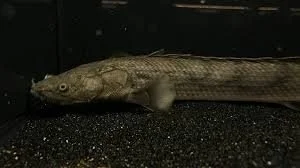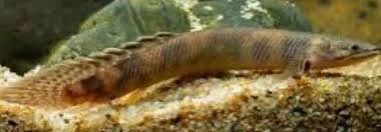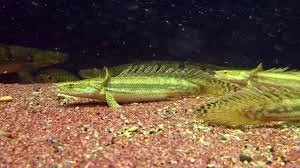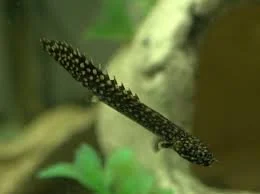 Image 1 of 1
Image 1 of 1


Bichir- Congo Giant XLarge 12-14 in
The "bich congo giant" most likely refers to the Congo bichir (Polypterus bichir congicus), a large, ancient-looking freshwater fish found in the Congo River Basin of Central Africa. It is an elongated fish with thick, ganoid scales, and its coloration is typically grayish-brown or greenish on the upper body, fading to a yellowish or white underside. These fish are known for their ability to breathe air and their unique, fleshy lobed fins, and while most bichir species are smaller, the Congo bichir can grow to a significant size, sometimes over 3 feet long.
Physical characteristics
Size: Can reach lengths of over 97 cm (38.2 inches) and weigh up to 4.4 kg (9.7 pounds).
Body shape: Elongated with a long body and a rounded tail.
Coloration: Upper body is brown, grayish, or greenish, with a white or yellowish lower side.
Scales: Covered in thick, ganoid scales.
Fins: Has fleshy, lobe-like pectoral fins and a series of dorsal finlets that run along its back.
Lifestyle and habitat
Habitat: Found in the freshwater systems of the Congo River Basin, living along the edges of streams and floodplains.
Behavior: These are nocturnal ambush predators that hide during the day and hunt at night.
Diet: Their diet consists of a variety of prey, including worms, aquatic insects, small fish, and amphibians.
Breathing: Bichirs have a unique adaptation that allows them to breathe air using their functional lungs, in addition to their rudimentary gills.
Reproduction: Male bichirs engage in a unique courtship dance, leaping from the water and twisting as they swim.
Other information
The "bich congo giant" most likely refers to the Congo bichir (Polypterus bichir congicus), a large, ancient-looking freshwater fish found in the Congo River Basin of Central Africa. It is an elongated fish with thick, ganoid scales, and its coloration is typically grayish-brown or greenish on the upper body, fading to a yellowish or white underside. These fish are known for their ability to breathe air and their unique, fleshy lobed fins, and while most bichir species are smaller, the Congo bichir can grow to a significant size, sometimes over 3 feet long.
Physical characteristics
Size: Can reach lengths of over 97 cm (38.2 inches) and weigh up to 4.4 kg (9.7 pounds).
Body shape: Elongated with a long body and a rounded tail.
Coloration: Upper body is brown, grayish, or greenish, with a white or yellowish lower side.
Scales: Covered in thick, ganoid scales.
Fins: Has fleshy, lobe-like pectoral fins and a series of dorsal finlets that run along its back.
Lifestyle and habitat
Habitat: Found in the freshwater systems of the Congo River Basin, living along the edges of streams and floodplains.
Behavior: These are nocturnal ambush predators that hide during the day and hunt at night.
Diet: Their diet consists of a variety of prey, including worms, aquatic insects, small fish, and amphibians.
Breathing: Bichirs have a unique adaptation that allows them to breathe air using their functional lungs, in addition to their rudimentary gills.
Reproduction: Male bichirs engage in a unique courtship dance, leaping from the water and twisting as they swim.
Other information





